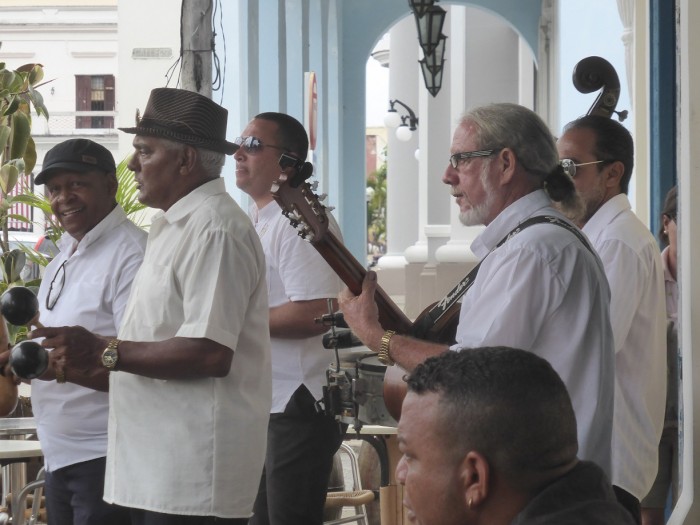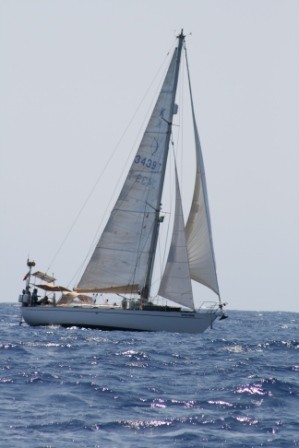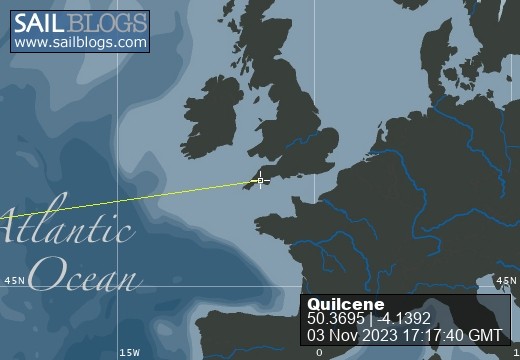
People of the Salt Water
03 November 2023 | Plymouth UK
03 November 2023
21 September 2022 | Shining Waters, St Margaret's Bay, Nova Scotia
30 August 2022 | Currently at Shining Waters, St Margaret's Bay, Nova Scotia
21 September 2019 | Currently on the hard at Souris, Prince Edward Island, Canada
26 August 2019 | Gaspe
11 August 2019 | Rimouski Marina, Province of Quebec
03 August 2019 | Longueuil Marina
09 June 2019 | Kingston, Ontario
07 June 2019 | Port Whitby Marina, Canada
01 October 2018 | Irondequoit, Rochester New York State, US
03 September 2017 | Port Whitby Marina, Ontario
07 August 2017 | Kingston, Ontario
05 July 2017 | Cobourg, Lake Ontario, Canada
25 June 2017 | Oswego
11 June 2017 | Waterford, NY
24 May 2017 | Port Washington, Long Island Sound, New York
11 May 2017 | Port Washington, Long Island Sound
28 April 2017 | Annapolis
23 April 2017 | Washington DC
First Impressions of Cuba
06 May 2016 | Varadero, Cuba
Belinda and Kit

Picture shows musicians outside Cienfuegos Bar/Cafe
View more pics at https://picasaweb.google.com/yacht.quilcene
We've been in Cuba a week now; When we pulled into the marina there was a welcoming party of dockmaster, Customs & Immigration, Police and Health officials, although contrary to what we'd heard from other yachties who'd checked in elsewhere and had all the different authorities on board, once they'd seen us arrive they drifted away leaving only one official to come aboard Quilcene and fill in all the forms for everyone. Joel from the Ministry of Health was very helpful and friendly and the whole process was completed in less than 30 mins. Perhaps he was elected because he spoke very good English!
Anyhow, this was quite a relief as we were tired and hot after the passage.
Cuba has long intrigued us, what is life like in a Socialist Republic? Is it really a daily struggle with downtrodden people queuing for hours to take home a loaf of stale bread? We knew that things were gradually changing here - i.e. the recent visit of a US President, but how has it been and how is it now?
Hopefully some of these questions will be answered by the time we leave!
The resort that Marina Gaviota is situated in is by no means representative of Cuba. We are surrounded by hotels and time-shares, together with expensive shops and restaurants. However it does make a good safe base to leave Quilcene. The marina itself is new and vast - and almost empty! We are one of only a handful of foreign boats in a marina built to berth 1100. Apart from us visiting boats there is a fleet of large catarmarans and motor boats which take coachloads of European tourists out on swimming/sunbathing/fishing trips daily. We know the tourists are principally Europeans because US citizens are still not allowed (by the US) to visit except for special purposes. I suspect this marina is hoping for a relaxation in this and an influx of Americans!
Our first trip into Varadero town was to see the Mayday parade and celebrations. Unfortunately the local bus was late that day so we missed the 8am parade. I guess it's held that early because later in the day the temperature soars to 38C and is too hot even for locals to be out in the sun!
Nevertheless when we arrived in town the Cubans were out in force. There was lots of music, dancing and appetising smells. The local beer (lager) was on sale at CUC $0.50 cents a can (CUC $2 in the resort bar). Incidentally 1 CUC dollar is equivalent to 1 USD. Many people proudly wore socialist red and the atmosphere was one of happy celebration. We wandered about, stopping for a fish roll - delicious and only 25 cents - and cold drinks. A dancing crowd was gathered around some drummers, one of whom had been drumming so long and hard that his fingertips were bleeding and bandaged (See Picasa pics) - still he drummed on! The whole town seemed to be out enjoying the day.
After a while we found a quiet Bodeguita for lunch then returned to Quilcene quite exhausted by the heat.
We'd already seen many of the old cars for which Cuba is famous; prior to 2008 Cubans were not allowed to buy or sell vehicles, and there were few foreign imports. Even today only 3.8% of Cubans own cars, mostly Old Ladas, ancient American cars and a few others. These have, of necessity, been lovingly cared for, spare parts cobbled together or cannibalised wherever possible from those that finally bit the dust.
The best ones are often used as taxis to subsidise low incomes, whilst others, held together by bits of wire, string and cardboard serve as transport.
With the aim of seeing more of life in Cuba we hired a car for a couple of days and headed off towards Cienfuegos on the south coast. As soon as we left the resort zone it was obvious how resourceful Cubans have to be; transport is often a bicycle or horse-drawn carriage. There are some buses, but as monthly salaries are still $25 tops, locals use Camiones, or trucks to move between cities. These resemble cattle trucks and look most uncomfortable but we often saw people queuing for them. Out in the countryside horse and carriage seemed to be more popular.
Straying from the main routes, roads are often deeply pitted dirt roads, even in towns, so we had to take great care not to take wrong turns.
Away from the towns there was very little traffic, but even so it took us 4 hours to travel 177kms. We found a Casa Particular (sort of B&B) on Punta Gorda, Cienfuegos, where we were welcomed with a Mojito cocktail we as sat on a deck over the bay and watched the sun sinking.
Cienfuegos is especially interesting for its architecture, a varied mix of early 1900's palaces and colonnades arranged around Jose Marti Square and listed as a World Heritage Site. We enjoyed coffee the inevitable music as we browsed around the sites and shops.
The square appeared to be quite busy and we discovered we were there on the same day as a party of Americans off the very first cruise ship allowed to visit Cuba. History in the making! We chatted to one passenger who said there were 700 people on board and of those 350 were journalists!
From Cienfuegos we made our way to Playa Giron in the Bahia de Cochinos, or Bay of Pigs. This was the site of a US backed invasion back in 1961. The invasion was a classic David and Goliath struggle in which David, in the form of Cuba, won the day, seriously embarrassing the US and demanding $53 million worth of food and medicines in return for the 1189 captured prisoners.
Today the bay is nothing more than another beach and the site of a derelict holiday camp.
Back aboard Quilcene we are making plans to visit Havana for a few days, so no doubt there will be more pictures and chat about this fascinating country.
View more pics at https://picasaweb.google.com/yacht.quilcene
We've been in Cuba a week now; When we pulled into the marina there was a welcoming party of dockmaster, Customs & Immigration, Police and Health officials, although contrary to what we'd heard from other yachties who'd checked in elsewhere and had all the different authorities on board, once they'd seen us arrive they drifted away leaving only one official to come aboard Quilcene and fill in all the forms for everyone. Joel from the Ministry of Health was very helpful and friendly and the whole process was completed in less than 30 mins. Perhaps he was elected because he spoke very good English!
Anyhow, this was quite a relief as we were tired and hot after the passage.
Cuba has long intrigued us, what is life like in a Socialist Republic? Is it really a daily struggle with downtrodden people queuing for hours to take home a loaf of stale bread? We knew that things were gradually changing here - i.e. the recent visit of a US President, but how has it been and how is it now?
Hopefully some of these questions will be answered by the time we leave!
The resort that Marina Gaviota is situated in is by no means representative of Cuba. We are surrounded by hotels and time-shares, together with expensive shops and restaurants. However it does make a good safe base to leave Quilcene. The marina itself is new and vast - and almost empty! We are one of only a handful of foreign boats in a marina built to berth 1100. Apart from us visiting boats there is a fleet of large catarmarans and motor boats which take coachloads of European tourists out on swimming/sunbathing/fishing trips daily. We know the tourists are principally Europeans because US citizens are still not allowed (by the US) to visit except for special purposes. I suspect this marina is hoping for a relaxation in this and an influx of Americans!
Our first trip into Varadero town was to see the Mayday parade and celebrations. Unfortunately the local bus was late that day so we missed the 8am parade. I guess it's held that early because later in the day the temperature soars to 38C and is too hot even for locals to be out in the sun!
Nevertheless when we arrived in town the Cubans were out in force. There was lots of music, dancing and appetising smells. The local beer (lager) was on sale at CUC $0.50 cents a can (CUC $2 in the resort bar). Incidentally 1 CUC dollar is equivalent to 1 USD. Many people proudly wore socialist red and the atmosphere was one of happy celebration. We wandered about, stopping for a fish roll - delicious and only 25 cents - and cold drinks. A dancing crowd was gathered around some drummers, one of whom had been drumming so long and hard that his fingertips were bleeding and bandaged (See Picasa pics) - still he drummed on! The whole town seemed to be out enjoying the day.
After a while we found a quiet Bodeguita for lunch then returned to Quilcene quite exhausted by the heat.
We'd already seen many of the old cars for which Cuba is famous; prior to 2008 Cubans were not allowed to buy or sell vehicles, and there were few foreign imports. Even today only 3.8% of Cubans own cars, mostly Old Ladas, ancient American cars and a few others. These have, of necessity, been lovingly cared for, spare parts cobbled together or cannibalised wherever possible from those that finally bit the dust.
The best ones are often used as taxis to subsidise low incomes, whilst others, held together by bits of wire, string and cardboard serve as transport.
With the aim of seeing more of life in Cuba we hired a car for a couple of days and headed off towards Cienfuegos on the south coast. As soon as we left the resort zone it was obvious how resourceful Cubans have to be; transport is often a bicycle or horse-drawn carriage. There are some buses, but as monthly salaries are still $25 tops, locals use Camiones, or trucks to move between cities. These resemble cattle trucks and look most uncomfortable but we often saw people queuing for them. Out in the countryside horse and carriage seemed to be more popular.
Straying from the main routes, roads are often deeply pitted dirt roads, even in towns, so we had to take great care not to take wrong turns.
Away from the towns there was very little traffic, but even so it took us 4 hours to travel 177kms. We found a Casa Particular (sort of B&B) on Punta Gorda, Cienfuegos, where we were welcomed with a Mojito cocktail we as sat on a deck over the bay and watched the sun sinking.
Cienfuegos is especially interesting for its architecture, a varied mix of early 1900's palaces and colonnades arranged around Jose Marti Square and listed as a World Heritage Site. We enjoyed coffee the inevitable music as we browsed around the sites and shops.
The square appeared to be quite busy and we discovered we were there on the same day as a party of Americans off the very first cruise ship allowed to visit Cuba. History in the making! We chatted to one passenger who said there were 700 people on board and of those 350 were journalists!
From Cienfuegos we made our way to Playa Giron in the Bahia de Cochinos, or Bay of Pigs. This was the site of a US backed invasion back in 1961. The invasion was a classic David and Goliath struggle in which David, in the form of Cuba, won the day, seriously embarrassing the US and demanding $53 million worth of food and medicines in return for the 1189 captured prisoners.
Today the bay is nothing more than another beach and the site of a derelict holiday camp.
Back aboard Quilcene we are making plans to visit Havana for a few days, so no doubt there will be more pictures and chat about this fascinating country.
Comments
| Vessel Name: | Quilcene |
| Vessel Make/Model: | Bowman 40 |
| Hailing Port: | Plymouth, UK |
| Crew: | Kit and Belinda |
| About: | |
| Extra: | Quilcene, a Bowman 40, is a masthead cutter designed by Chuck Paine and built in 1991. The name is an American Indian word meaning 'People of the Salt Water', which we feel suits us very well. Quilcene is also a town on the West coast of the USA near Seattle. |

Who: Kit and Belinda
Port: Plymouth, UK

